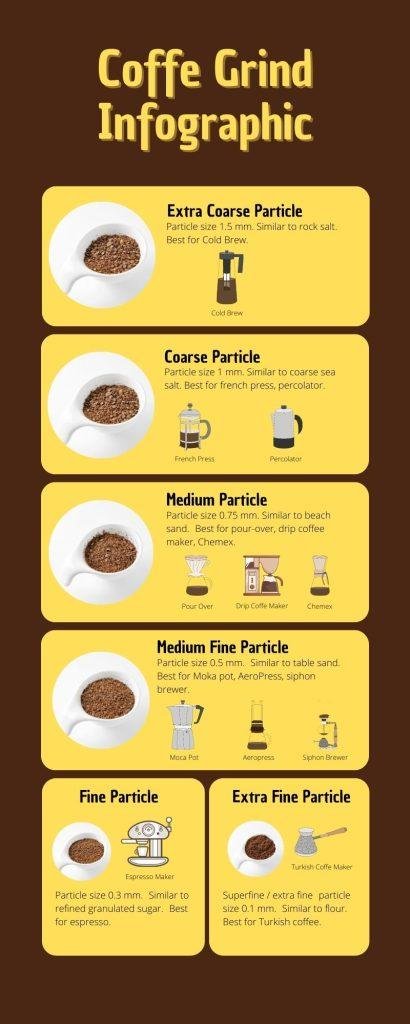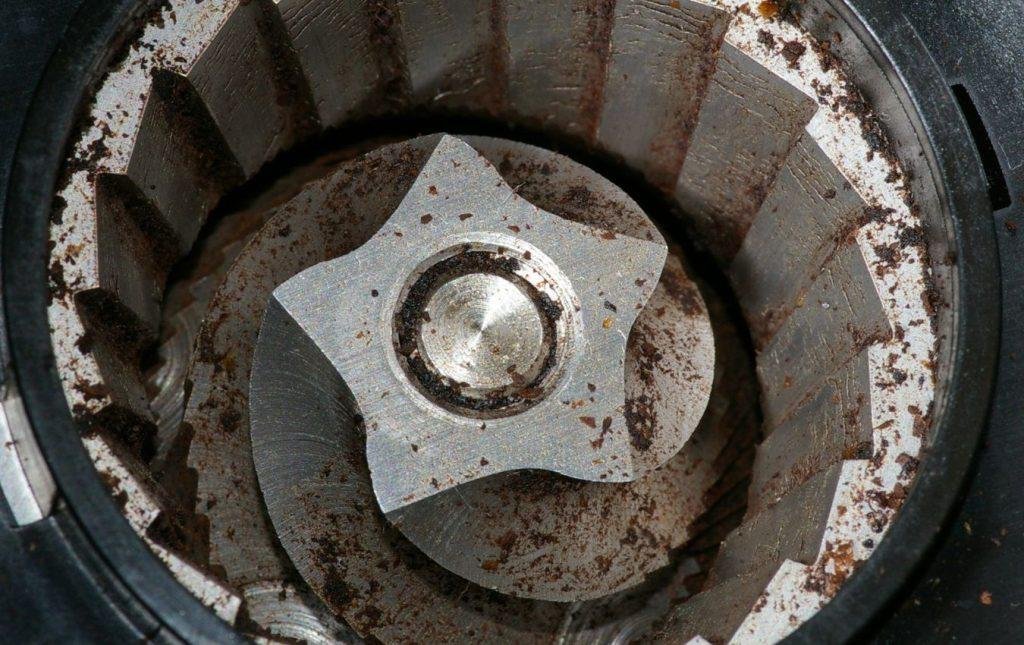The smell of fresh ground coffee beans is one of life’s simple pleasures. But to get the best coffee, you need to grind your beans properly!
Coffee grinders are an essential piece of equipment for any coffee enthusiast. With the right grinder, it is possible to make a delicious cup of espresso or brew some strong French press coffee easily.
But before you can get started, you need to decide which type of grinder is best for your needs. This guide will provide an overview of the different types of coffee grinders, their advantages and disadvantages, and how to know which type is best for you.
How Grinders Affect the Coffee
Before diving into the four types of grinders, it’s important to understand how a grinder affects the flavor of your coffee. The grounds’ size and shape affect how much flavor is extracted from them when brewing.
Here is a coffee grind infographic to help you better understand the different grind levels:

The finer a grind is, the more surface area it has for water to extract flavor. The grind should be fine and almost like a powder for Turkish coffee and espresso, whereas the grind should be coarser for French press and pour-over coffee.
Types of Coffee Grinders
While there are many variations of coffee grinders, they are generally divided into four categories: blade grinder, burr grinder, manual grinder, and electric grinder.
Electric Grinders

Are you in a hurry but still need that fresh cup of coffee to kickstart your morning? Electric grinders are the perfect solution. They offer more grind settings and can grind larger quantities of fresh coffee with the push of a button. However, convenience and efficiency come at a price; high-end electric grinders can cost at least $100+.
While investing in a high-performance grinder will give you the best results, even the nicest electric grinders available have a few disadvantages. These include being noisy and requiring constant maintenance. Cheap electric coffee grinders often use low-quality materials and parts that produce irregular grind sizes and wear down quickly.
From a convenience standpoint, an electric coffee grinder is ideal. But manual grinders are an effective alternative if you’re looking to save a little money and don’t mind the extra effort.
Manual Grinders

Manual coffee grinders are the perfect choice for coffee connoisseurs who don’t have time for electric grinders and want a more hands-on approach. Manual grinders use a hand crank to grind beans and are usually made with metal or ceramic burrs.
Brewing coffee with a manual grinder takes time and requires some elbow grease, but it can yield an incredibly flavorful cup of joe. Manual grinders are usually more affordable than electric ones, require no electricity to operate, and are typically more durable.
And because the beans must be ground on demand, they won’t work well if you’re in a hurry or need to brew large quantities at once.
Blade Grinders

Have you ever bought pre-ground coffee and thought it tasted a bit off? That could be because blade grinders are the most common type of grinder and are known for their inconsistent grind size.
Blade coffee grinders work by chopping beans up using a spinning blade like a food processor. The problem with this is that the size of the grounds can vary significantly, and some may be over-extracted while others are under-extracted.
This type of coffee grinder is usually the least expensive and is a good choice for someone who only occasionally drinks coffee or wants an entry-level grinder.
Burr Grinders

If you’re serious about getting better-tasting coffee, then burr grinders are worth the investment. Unlike blade grinders, burr coffee grinders use two serrated plates to grind beans into even-sized particles. The freshly ground beans will give you a richer, more flavorful cup of coffee.
A burr grinder also has an adjustable grind setting that allows you to control the coarseness of the grounds so you can always get the perfect cup of coffee. They are generally more expensive than blade grinders but will give you better-tasting coffee in the long run.
Burr grinders come in two types: flat burrs and conical burrs.
Conical Burr Grinders
From the outside, these two types of burr grinders look very similar. However, they have one important difference – conical burrs use two sharp cone-like ridges to grind your coffee beans into two different sizes. The coarsest setting on a conical burr grinder will be the larger of these two sizes, while the finest setting will be the smallest.
Although conical burr grinders don’t always produce a consistent grind, they are cheaper, quieter, and easier to clean and maintain and produce less heat than flat burr grinders. This makes them a great option for casual home baristas who are looking for an affordable grinder that is easy to use and maintain.
The heat generated by a conical burr grinder can cause the coffee beans to scorch, resulting in a bitter taste. While this is not common, it can be avoided by making sure the grinding burrs are kept clean and free from debris.
Flat Burr Grinders
As a true coffee aficionado, you may be looking for a flat burr grinder. Flat burr grinders churn out more evenly sized coffee grounds which can greatly enhance the flavor of your brew. They are also more easily and accurately adjusted for different grind sizes.
However, flat burr grinders come with some trade-offs – they are expensive, noisy, and difficult to clean. They also generate quite a bit of heat which can be damaging if the burrs are not kept clean and free from debris.
At the end of the day, a flat burr grinder may be worth the investment if you are looking for the potential of more even grounds and better flavor, but conical burr grinders are still a great option for those on a budget.
Coffee Makers with Built-in Grinders

For the ultimate convenience, you may want to consider a coffee maker with a built-in grinder. These machines will grind the beans right before brewing, ensuring that you get a fresh cup of coffee every time. These machines are usually more expensive than buying a separate grinder and brewer but can save you time and energy when making your morning cup of joe.
Most of these machines use dosing grinders which dispense a pre-measured amount of grounds into the portafilter. This ensures that you get a consistent, even grind every time and makes it easier to get the perfect cup of coffee. Usually, you can choose from several preset grind settings, and some even allow you to adjust the grind size manually.
These machines can be a great investment for coffee drinkers who are on the go and don’t want to sacrifice quality for convenience. While grinding your own coffee beans is always preferable, if you’re looking for a hassle-free way to get your daily caffeine fix, then buying an espresso machine with a built-in grinder is the way to go.
Final Words
No matter what type of coffee grinder you choose, it is important to remember that a quality grinder can make all the difference in the taste of your coffee. Investing in a good grinder can save you time and money in the long run, so it is well worth the initial cost.
Now that you know what kind of coffee grinder is best for you, it’s time to put your knowledge into action. So grab your coffee beans, grind them up, and get ready to enjoy the perfect cup of Joe!
